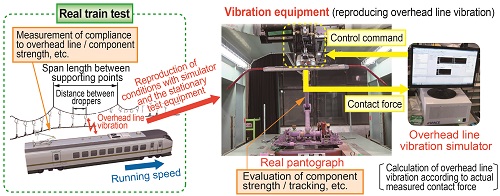26. Current collection HILS system enabling simulated running tests
In the process for developing pantographs, before actual vehicle tests are conducted, each component of the new pantograph has to be tested on test rigs for resilience of structural members and ability to comply to the vibrating overhead contact line (OCL). Existing test rigs however, are unable to fully reproduce the vibrations generated by the swaying movement of the OCL as a pantograph moves along it, as in real running conditions. This means that in actual vehicle tests, some pantographs may not produce the same performance as verified in preliminary functional bench tests, and until now, the only way to resolve design problems was to carry out repeated adjustments and tests.
Consequently, a current collection HILS (Hardware In the Loop Simulation) system was developed which enables simulated running tests with stationary pantographs to examine the interaction between pantographs and overhead contact lines (Fig. 1). The system calculates the OCL vibration that would be generated by a passing pantograph during running in real time, which controls the vibrating equipment, reproducing the vibration conditions of a pantograph running under an OCL.
A comparison of the results obtained from the test equipment reproducing running conditions at 300 km/h with target values (set by simulation of the overhead line / pantograph system) showed that the frequency response up to 20Hz correlated well, and confirmed that the simulated running test of a pantograph was able to reproduce conditions which could examine the influence of OCL vibration due to the periodicity in OCL structure and wave propagation generated by the pantograph under running conditions for speeds up to 300 km/h (Fig. 2). Given that the conditions reproduced in these stationary tests are very close to real train tests, the newly developed system should be able to reduce the time required to develop new pantograph designs.
Other Contents
- 25. Method for measuring dynamic deformation of brake disc
- 26. Current collection HILS system enabling simulated running tests
- 27. Reproduction of meandering airflows under the carbody through numerical simulation
- 28. Wind tunnel tests reproducing the wind force resulting from natural wind and vehicle velocity to evaluate aerodynamic forces acting on railway vehicles
- 29. Wind tunnel tests for detailed detection of sources of aerodynamic noise from bogies
- 30. Assessment of driver state based on physiological indices
- 31. Multi-segment pantograph head with high compliance to contact wire fluctuation
- 25. Method for measuring dynamic deformation of brake disc
- 26. Current collection HILS system enabling simulated running tests
- 27. Reproduction of meandering airflows under the carbody through numerical simulation
- 28. Wind tunnel tests reproducing the wind force resulting from natural wind and vehicle velocity to evaluate aerodynamic forces acting on railway vehicles
- 29. Wind tunnel tests for detailed detection of sources of aerodynamic noise from bogies
- 30. Assessment of driver state based on physiological indices
- 31. Multi-segment pantograph head with high compliance to contact wire fluctuation


